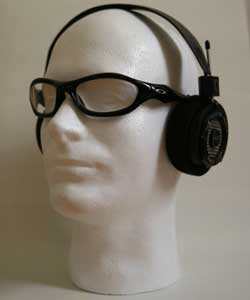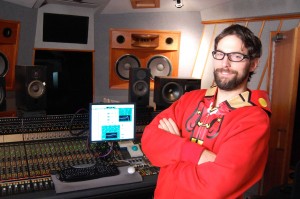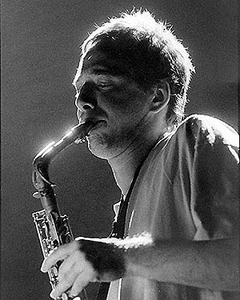Borne of John Zorn: Marc Urselli Records NYC’s Marathon Man
The free flow of creativity from New York music force John Zorn never ceases to inspire. If he can create what must be thousands of recordings by now, and head up the extremely productive Tzadik label, then you should be able to get your own catalog moving as well.
Along for the learning right now is NYC engineer/producer Marc Urselli. This is one of the guys that’s always busy, a three-time GRAMMY winner with credits that include Les Paul, Lou Reed, Laurie Anderson, Sting, Joss Stone, Lila Downs, Eric Clapton, Jeff Beck, Mike Patton, Keith Richards, Buddy Guy, Richie Sambora, Johnny Rzeznick (Goo Goo Dolls), ZZ Top, Sam Cooke, Aerosmith’s Joe Perry, Simply Red’s Mick Hucknall, Luther Vandross, Simple Minds and a bunch more (http://www.marcurselli.com/music).
Being a go-to guy for Zorn, whose nonstop contributions to jazz, world sounds, and experimental music just keep on coming, keeps Urselli’s schedule even busier.

Marc Urselli is no dummy
Q: I kind of think of you as having an audio “practice”. Is this correct? What are the different things you do professionally?
A: Ha ha., the doctor will see you now! Well, sometimes I do feel like a doctor. Some of my patients have serious illnesses, such as “I-suck-but-I-wanna-be-a-star”-itis or “I-can’t-sing-and-you-need-to-fix-my-voice”-it is. Or hallucinations such as “Yo-this-is-gonna-be-a-hit-man-so-you-should-work-with-me-for-free”.
Luckily, I am also blessed to work with some of the most incredible artists of our time who don’t require much or any doctoring of that kind at all. But if you like the doctor-metaphor, I guess I can say that I use my tools to make people be as healthy as possible. There must be a reason why “healthy” is synonymous with “sound”!
To answer your questions exactly, though, I do a lot of things professionally: Primarily I engineer, mix and produce records — which of course includes all the editing that is necessary to make everyone sound perfect. I also do quite a bit of live sound and touring, I do sound design for commercials, I compose, I write for some music magazines, I run my own music website and do a few other things.
Q: Seems like everyone I know these days is doing either just one thing, or a wide variety of projects. Are you primarily based out of East Side Sound, where I first met you? Why do you like to work at that facility?
A: I am a freelancer and have worked in several studios, but if the client leaves the choice to me I always choose to work at EastSide Sound because it’s just the best studio in town.
I’ve worked at other studios in NYC and outside NYC, and there is no place I know of that has the amount of isolation – seven isolated rooms with line of sight — and the amount of gear that EastSide has. Plus. EastSide has a super cool and chill vibe that musicians respond very well to. The combination of recording spaces and quality (and quantity) of gear is unique.

EastSide Sound’s Harrison console is a standout.
Also EastSide Sound has a Harrison board, which is one of the most amazing and best- sounding boards I worked on, which lets me do mixes in the analog domain with total automation — beyond just faders, I’m talking EQs, pans, reverb sends, dynamics etc… and total digital recall — so that I can recall an analog mix a year later within seconds).
In addition to all of that I have some of my gear there — Focal monitors, JZ microphones, Rode microphones, McDSP plugins, IK Multimedia plugins, etc… — so I’m comfortable and I feel at home. It’s just a great hybrid of vintage gear, modern technology as well as old-school studio design and new-school philosophy. EastSide has been around since 1973 and is doing OK considering the times we are in and all the studios closing, So obviously we’re doing something right over there, you know?
Q: I agree about that Harrison board, I really enjoyed mixing two Impossible Objects songs through it with Fran Cathcart over there. So how would you describe the musical space that John Zorn currently occupies? What kind of artist is he, and what does his body of work represent in the canon?
A: Zorn to me is one of the most interesting composers and musicians of our time — I absolutely love his music and love working with him. He’s a true genius, and his work ethic is second to none. He is eclectic, prolific, focused and dedicated to the music. Everything he does, from his own music, to the Tzadik label he runs to his music venue, The Stone, he does with love and out of love for the music. His body of work is incredible — hundreds of records to his name — and his strength is probably in the variety of his composition.
What I love about working with him is that it is always different, always exciting. He writes jazz in its many variations and flavors, rock/metal, classical music, avantgarde/ experimental music and more often than not his music is a mixture of all of the above, which is incredibly interesting.
I’ve recorded and mixed more than a dozen of his albums now, and in doing so have found myself employing tried-and-true mic techniques on jazz quartets, recording chamber-like string trios, doing vocals-only albums, capturing rare and out-of-the-ordinary percussion instruments and other sound-making devices. Or I’ve been bouncing my head up and down in the control room while tracking double drum sets, a distorted bass, screaming vocals and Zorn’s incredible sax playing.
On top of that Zorn uses some of the most incredible musicians out there and it’s a pleasure for me to even just watch them play, let alone record them. I love the fact that there’s so much variety because I grew up listening to all sorts of different music, and I’m always excited about every record I get to do with him. Zorn’s simply the man!
Q: When you first told me you had worked recently with John Zorn, I thought you had worked on a finished album. But you referred to your recordings with him as an “ongoing collaboration”. Can you explain how it’s working?
A: Well, like I said, John is very prolific and we enjoy working together very much. We first worked together on his album The Dreamers — one of my favorite to this date — and we’ve worked together ever since, which means about 15-20 records now.
You have to understand: the man is totally dedicated to his music and the musicians he uses have incredible amounts of talent. This translates into relatively short sessions. I think the longest session I did with him was three days of tracking and two days of mixing, and the shortest session was one 12-hour day of recording and mixing 10 songs!
The average is around 1-2 days for tracking and one day for mixing.
We’ve got the system down and we work fast, no breaks, no food, no messing around. I know what he wants and what he likes and I strive to make it perfect. I get there hours before he comes in to set up everything so that he can come in, sit down and get to work teaching the first song to his musicians. By the way, they never get to practice the music before they come in for the session. They learn it on the spot, try it a few times and then record it in one or two takes, sometimes three… and all of this sight-reading extremely difficult sheet music and soloing on top of crazy time signatures!
John is surrounded by talented people and we are kind of a team and everyone in the team cares about the music and takes it seriously. Kaz does the label, Heung Heung does the artwork etc… Everyone gives their 200% and when I work for him I give my 200%, because those are some of the sessions I really look forward to doing.

John Zorn
Q: How does such a high volume of consistent output affect the way you engineer and produce? Both working with him, and in turn working with other artists?
A: I would say it affects it very positively when working with him because there is a level of trust, knowledge and comfort that might not be there with an artist you never worked with before. In other words, with John I know what he wants, so I can give him what he wants very quickly and efficiently. If he had to work with a new engineer every time it most likely wouldn’t be as fluid and smooth as it is.
Other artists are unaffected by all of this, but needless to say, the more I work with any artist the better I get at what I do and the faster I get at what I do. EastSide has become second nature so it’s really easy for me to get good sounds there, because I know the rooms, the outboard, the mics, so well.
It goes without saying that my Pro Tools chops are sharp and I can fly on the machine doing all the transport operation, editing and automation at lighting speed, which clients love, because it saves them time, which equals money and makes them sound good. I hate to say this, but speed has become an important factor in today’s industry — but this plays to my advantage because of how fast I am.
Q: What are some highlight duets/musical collaborations of Zorn’s from recent sessions? Tell us about recording the vocal four-piece, Mycale.
A: There’s been many. He always uses amazing players like bassists Greg Cohen, Trevor Dunn and Shanir Blumenkranz; guitarist Marc Ribot; drummers Joey Baron, Ben Perowsky, Kenny Wollesen, also a vibraphonist; percussionist Cyro Baptista; pianists Rob Burger, Jamie Saft and Uri Caine, and so many more: Erik Friedlander, Carol Emmanuel, Ikue Mori, Fred Frith and the list goes on. We did a record with Phantomas/Faith No More singer Mike Patton, which was pretty amazing too.
The Mycale record was an interesting one — it was one of two vocals-only CDs of John’s music that I recorded. Mycale is a group of four talented young women who took some of Zorn’s music and arranged it for their voices, on their own, over the course of a year. It’s a very interesting record that brings together four different voices, styles and even languages!
We recorded another similar record with a different group of singers that became the music for French director Arno Bouchard’s film The Last Supper. John does a lot of soundtrack work and this latter group of amazing singers is the same that does the live performance of “Shir Ha-Shirim/The Song of Songs”, which is one of Zorn’s many musical projects for which I had the pleasure of doing live sound in a few occasions.
Q: Do you also work with the artists on his label? What kind of music does he distribute?
A: I have worked — as in recorded and mixed — several albums for Tzadik. Mostly it was artists based in New York, except in one or two cases. John releases and distributes the music he likes, which is how it should be for every label out there.
Q: Do you still maintain Chain D.L.K.? What is that, and how did it inform your work as an audio pro?
A: I do still run it. Chain D.L.K. is a music magazine for electronic, industrial, avantgarde, experimental music. I founded it in 1994 as a paper magazine and now it is online only at http://www.chaindlk.com and has over 30,000 visits per month.
Chain D.L.K. has really nothing to do with my work in the audio field. It is not about technical information, but rather music news, reviews, interviews, forums etc… It is a completely non-profit venture — in fact I lose money every month out of my pocket — but I do it to support the music and the artists, and to offer exposure to artists who otherwise might not get as much. I do it out of pure love for the music.
Q: You are originally from Switzerland, and then grew up in Italy before making it to American shores. Why do you enjoy being NYC-based? What makes this a great place to work, and what’s also making it challenging?
A: NYC is the greatest city on earth. Just walking down its streets inspires me. There are a few other cities I feel that strongly about, but NYC is at the top of my list and I don’t think I could live anywhere else.
Obviously it is a great place to work populated by some of the most amazing artists out there. Of course it is also challenging, it’s a tough city, it makes you or breaks you, and there’s competition for everything. But I like the challenge, it keeps me sharp and keeps me moving forward.
Q: Word. Is it true you can go kite surfing in Brooklyn? What’s it like to kite surf? Inquiring minds want to know.
A: Ha ha, I love kitesurfing! We go to several places in Brooklyn and also Long Island. Kitesurfing is equal part rush of adrenaline and equal part zen-like experience. You are out there alone with the elements, which can be very relaxing and spiritual in a sense, but you can also rip great air, pull off air and board tricks, surf waves, explore the canals between the grass islands of Long Island’s Great South Bay and hurt yourself in more ways than you can imagine!
Q: OK, I really want to come with you sometime. What’s next for you?
A: A kitesurfing trip to Brazil, a new record with Zorn (for which we start tracking four hours after I land at JFK airport from my 17 hour redeye return flight from Brazil), two other Tzadik records in December, a possible second half of tour with Marianne Faithfull in January (we did a first leg two months ago), a Masada live marathon and hopefully more interesting records of beautiful music for the world to enjoy!
Q: Gee, sounds awful. Anything else you want to add?
A: You tell me, I feel like I bored you and everyone else enough with my chatter. I am just enthusiastic about music, I love music deeply and I care about what I do and do it as best as I can. I wish there were more amazing artists like Zorn out there and that more people were into music for the right reasons and with the right attitude. Music is
the only universal language and I wanna learn to speak all of its dialects! – David Weiss
Please note: When you buy products through links on this page, we may earn an affiliate commission.







marcurselli
November 16, 2009 at 9:31 pm (15 years ago)Thanks for the interview David, Sonic Scoop rocks!
marcurselli
November 16, 2009 at 2:31 pm (15 years ago)Thanks for the interview David, Sonic Scoop rocks!